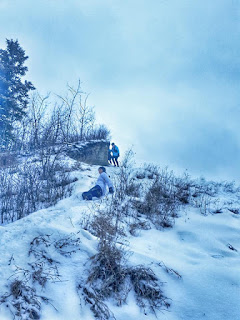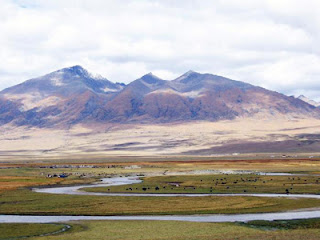2019 River Valley Revenge Winter Edition 50k
Signing up
Some 20 or so months ago, still contemplating a possible move from Maryland to Edmonton, I was googling ultras in Alberta (of course) and came across a disturbing photo.
There, on the home page of a twice-annual event called the River Valley Revenge, was the photo of a runner, his face and beard frosted over, perched precariously on a narrow trail above a frozen river. It looked horrifying. I also knew if we made the move, I'd be signing up someday.
After semi-hibernating my way through our first Edmonton winter, and having run (or attempted to run) the summer edition of RVR, I at last felt ready, ready-ish, to sign up for the 50K this past January.
Orientation

For anyone new to this race and the Edmonton river valley, I can't emphasize enough the value of the Orientation Clinics put on by race organizers Todd and Sheryl Savard. For me, the Orientation I attended two weeks before the race was a wake-up call.
Before coming to Edmonton, my idea of a "river valley" was something bucolic--lots of gently winding, green-shaded single-track. My experience in the summer RVR had disabused me of that misconception. Still, the morning run at Orientation highlighted my continued lack of readiness for this uniquely challenging landscape. The gentle trails of St Albert where I do most of my training just don't cut it.
I learned, first of all, that I needed better traction. By the time I finished the run, my shattered Yaktrax were tossed in the garbage. I also came away with a tangible reminder: a broken, or at least badly bruised, tailbone acquired when I somehow found the one exposed rock in a an icy downhill descent that landed somewhere between bum-slide and free fall.
Leg 1: Race HQ to Aspen Gardens (12.5K)
The day dawned cold, but not too cold, and kept at a steady -15C or so throughout. Aside from some wind in the (rare) exposed areas of the course, this was a comfortable January day in Edmonton. Not too cold, not too warm. Equipped with my new Kahtoola spikes and judiciously dressed (or so I thought), I felt ready and restless to go.
No one wanted to spend time standing on the windy starting line, so there was a very brief huddle followed by the usual muted ultra start ("Are we running now??").
I settled in quickly. Five years of meditation on top of forty of years of running has finally shown me what an addled mess our minds (mine at least) can be in the first hours of an ultra. So much mental energy is wasted in those early stages. I was determined to allow whatever would be to just be.
 That meant expecting the unexpected, which came quickly, as we were rerouted in the first few kilometers along a frozen creek. It was no big deal for most of the runners, I'm sure, and actually quite beautiful in places (the frozen falls). For me though, this was an early test.
That meant expecting the unexpected, which came quickly, as we were rerouted in the first few kilometers along a frozen creek. It was no big deal for most of the runners, I'm sure, and actually quite beautiful in places (the frozen falls). For me though, this was an early test. I have an almost dangerous lack of fear around heights. But after a serious accident a few decades ago--a fall through an attic floor that gave way--I can be paralyzed by the feeling that I'm standing on an unreliable surface. Such as thin ice.
At one point in the frozen creek passage, I tried to climb up an embankment, thinking I would follow another runner who seemed to get up and around easily enough. I made it about halfway up...then slid down, lodging in one of the many fallen trees that crisscrossed the stream. I sort of lay there for a bit, watching runners skitter by on the ice.
I disentangled myself from the tree and got back on the ice. Almost at the end of this section, my left foot went through. Swearing, I quickly calmed myself with the thought that at least one foot was dry. Then the right went through.
On firm ground again, my feet seemed to dry quickly (or at least I didn't feel them), and I began moving along well, getting into a good rhythm. At the race briefing, we had been told that the course has "some big hills at the beginning, at the end...and in the middle" (laughter). That said, there are some solidly runnable sections (assuming you have the right traction), and from the frozen creek to the turnaround at 12.5K were really enjoyable. I almost felt too good. This was just another long run in the great outdoors.
Leg 2: Aspen Gardens to Race HQ (25K)
 Reaching the second aid station feels like a milestone and celebration. You make your way up a steep hill, dodging the downhill-bound runners, some of them still taking in food and drinks. Tempting as it was to linger up top, I fueled up quickly and headed down.
Reaching the second aid station feels like a milestone and celebration. You make your way up a steep hill, dodging the downhill-bound runners, some of them still taking in food and drinks. Tempting as it was to linger up top, I fueled up quickly and headed down. Moving well, I began gaining on a number of 50k runners who had left me behind at the frozen creek. I fell into stride with a pack that included Rae-Ann Gill, a 17-year-old who finished (as I did not) the RVR 100 miler on this course last summer, as well as Tess Owen, who would keep me company into the second loop as the rest of pack gradually fell off.
The third section, from 12.5K to 19K, was a bit of a rollercoaster, with no very large hills, but a great many smaller ups and down. With all the gear shifting, it was difficult to get a consistent rhythm going, and I was happy to see to the bridge.
The happiness didn't last too long, as the fourth leg, from the Fort Edmonton aid station at 19K to the finish, took us along a long a classic Todd Savard trail, better suited to coyotes than people. There was crawling involved. There were moments of standing at the bottom, or top, of a hill and thinking there is no way, absolutely no way, I'm getting up or down. Then plunging ahead anyway.
Loop 2: Race HQ (25K) to Finish (50 K)
That sense of well-being, of playing in the woods, that I had during much of the first loop? Gone, almost as soon as I began the second loop. The day began to feel longer, the distance between aid stations stretched further.
This time through the frozen creek, I made no attempt to bypass, and nearly made it to the end of the stretch dry. Then, I two-footed it through the ice in the final section.
I tried to stay with Tess, but she left me behind in the first leg. I wasn't alone, however. During the second loop, there were more and more runners about--relay runners and 25K-ers--moving quickly on fresh legs. It was encouraging and dispiriting at the same time, but at least I didn't worry about my usual nemesis--getting lost.
The mind games began in earnest. I realized I couldn't tell whether my well-watered toes were warm or cold (in fact, as I would painfully discover after the race, they were encased in ice most of the day). It also dawned on me that I had made an error in not packing a jacket, or putting on another layer, for the second loop. While I have run in much colder than -15C before, and it really isn't that bad--a whole day of outdoor exposure is another matter. Things change after five or six hours out there. To gathering fatigue and a thin but growing edge of worry was added the sluggishness of my gradually cooling core. My movements became increasingly stiff, clumsy, slow.
Somewhere on the third leg of the second loop, I began to bonk. That in itself was not a worry: it seems to happen around the six hour mark in almost every ultra, and I knew that if I just slowed to eat more, alternate running and walking, that I would come out of it soon enough. As I did. But at a cost: the third leg left me colder than ever.
Final leg: 19K to the Finish Line
Somewhere on the third leg of the second loop, I began to bonk. That in itself was not a worry: it seems to happen around the six hour mark in almost every ultra, and I knew that if I just slowed to eat more, alternate running and walking, that I would come out of it soon enough. As I did. But at a cost: the third leg left me colder than ever.
Final leg: 19K to the Finish Line
 In every race, it's helpful to have some mantras, and in this one I took away something Steph Neufeld said in the "coaches corner" portion of the Orientation Clinic. "Suffer more." She said this in response to a question by another 50-something runner in the audience about how you set new goals when you've run along time, when you've "been there, done that," when you've run umpteen ultras, when just finishing isn't enough, and when your fastest times are way behind you?
In every race, it's helpful to have some mantras, and in this one I took away something Steph Neufeld said in the "coaches corner" portion of the Orientation Clinic. "Suffer more." She said this in response to a question by another 50-something runner in the audience about how you set new goals when you've run along time, when you've "been there, done that," when you've run umpteen ultras, when just finishing isn't enough, and when your fastest times are way behind you? What she meant, or at least how I chose to take it at this particular moment in the race, was the need to hold yourself to a higher standard of inner honesty.
It would be so easy to dial things back. Just a little. Finish whenever you finish. What do you have left to prove anyway? You're a busy guy, lucky to train two days a week, and besides, there are so many good excuses ready at hand. And really, who will care, who will know? The answer is the same. "Suffer more." It's the answer to those voices that come, as they will always come, at this stage in the race (or this stage of life).
Finish and aftermath
Head games and the worst of the terrain over, I "coasted" through the last few, gentle and easy kilometers--although they seemed to take forever, winding and winding us around in circles, so close to the finish. But at last it was over. My first thought on crossing the line was pleasure at having made it in well before sunset, and without needing to brave the final leg in darkness.
For runners contemplating signing up for this race, in whatever distance, 5K to 50--I highly recommend it! With aid stations every 6K or so, fantastic volunteers, clearly visible signage, and more or less constant company on the course, this is a movable party in the snow.
Best of all is the spirit of the people, the passion and commitment and caring of the race organizers and volunteers, the sense of a common cause, and the warm embrace of a seemingly inhospitable climate and rugged landscape. In retrospect, the RVR Winter 50K felt to me like something of an milestone. A bit over a year since my wife and I moved to Alberta, I felt at home.




Comments
Post a Comment